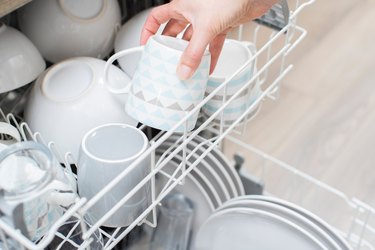
A quality dishwasher cleaner is great at getting gunk off of the plates, pots and pans while also getting the glassware to sparkle. But when it doesn't dissolve, it doesn't get the job done.
From the water temperature to the level of soap buildup in dishwashers, there can be a few reasons why the detergent is left in a congealed mess after the washing cycle is complete.
Video of the Day
Video of the Day
Soap Buildup in Dishwasher
Soap buildup in the dishwasher can stop the appliance from working well, leaving spots and streaks on dishes. Taking a scrub brush and gentle commercial cleaner with bleach can quickly take down layers of soap scum from the heating element, washer arms, baskets and heating element.
After scrubbing the interior of the dishwasher, run a cycle with 2 cups of vinegar placed in the bottom of the tub. This will rinse out any clinging bits of soap scum from the many moving parts of the dishwasher.
Removing soap buildup on a regular basis will keep the dishwasher in good working order. Once a week, place 1 cup of vinegar and 1 cup of rubbing alcohol in the bottom of the tub and run the dishwasher on a regular cycle. This can be done with the appliance empty or full.
Citric Acid to Clean a Dishwasher
The limonene in citrus-based natural cleaners can take down limescale, as well as soap buildup, in dishwashers. Citrus powder or crystals also work well in taking down tough soap buildup in the appliance, according to House Cleaning Advice.
Pour the citrus crystals or packet of sugar-free lemonade into the bottom of the dishwasher tub. This can be done when the dishwasher is loaded full of dirty dishes or empty. Run the appliance on a regular cycle to clean out the jets on the arms and other interior nooks and crannies.
Cleaning the Heating Element in the Dishwasher
There are a few ways to safely remove limescale from dishwasher heating elements. You may want to unplug the appliance first, before starting the cleaning process, if you are worried about the function or integrity of the machine's electrical system.
Use rubbing alcohol or acetone to remove baked-on soap scum, limescale or food bits on the heating element. Soak a clean cloth in either cleaner and place on the heating element for at least five minutes and up to 20 minutes. Wipe the element clean with the cloth and repeat if necessary.
Temperature Troubleshooting for Undissolved Detergent
When the dishwasher's temperature is below 110 degrees, then the environment may not be hot enough to dissolve detergent tablets. That can depend on the brand of both the dishwasher and the detergent. This is why it's a good idea to test different brands of detergent with your dishwasher and check the temperature of the water before taking the appliance apart to clean from top to the bottom of the tub and heating element.
An easier way is to test the water that pours from the kitchen faucet, according to Remove and Replace. This is the same source of water for the dishwasher. Turn the sink on, fill a cup and place a thermometer in the cup for a few minutes for a good read.